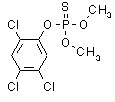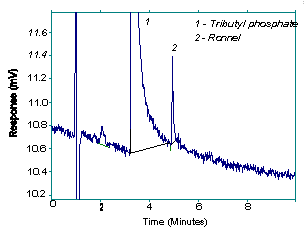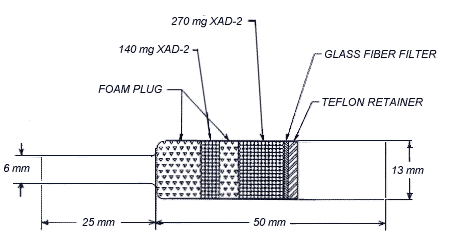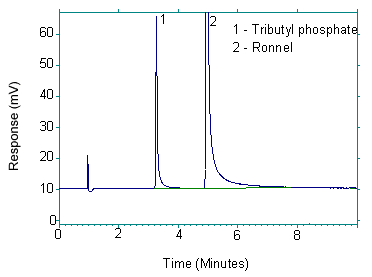RONNEL
| Method number: | PV2054 |
| Matrix: | Air |
| Target concentration: | 15 mg/m3 (OSHA PEL) |
| Procedure: | Samples are collected by drawing a known volume of air through
OSHA versatile sampler (OVS-2) tubes, containing a glass fiber
filter and two sections of XAD-2 adsorbent. Samples are desorbed
with toluene and analyzed by gas chromatography using a flame
photometric detector |
| Recommended air volume and sampling rate: |
60 L at 1.0 L/min |
| Reliable quantitation limit: | 0.031 mg/m3 |
| Status of method: | Partially Evaluated Method. This method has been subjected to established evaluation procedures, and is presented for information and trial use. |
| Date: October 1994 | Chemist: Ing-Fong Chan |
OSHA Salt Lake Technical Center
Salt Lake City, UT 84165-0200
1. General Discussion
- 1.1 Background
- 1.1.1 History
This evaluation was undertaken to develop a sampling procedure for ronnel, an organophosphorus pesticide. National Institute of Occupational Safety and Health (NIOSH) recommended using a mixed cellulose ester membrane filter (37-mm) with a glass tube containing chromosorb 102 resin (66/33 mg section, 20/40 mesh) for sampling ronnel (Ref. 5.1.). The OVS-chromosorb 102 tube is not available commercially. The sampling procedure specified in this method uses an OVS-2 tube which is commercially available. It is also used in sampling many other organophosphorus pesticides (Ref. 5.2.).
1.1.2 Toxic effects (This section is for information only and should not be taken as the basis of OSHA policy.) (Ref. 5.3 )
Ronnel is an indirect cholinesterase inhibitor. The acute oral LD50 has been found to be about 1250 mg/kg for the male rat and 2630 mg/kg for the female rat. Other species tested have shown comparable reactions, with the dog having an oral LD50 greater than 500 mg/kg.
1.1.3 Workplace exposure
Ronnel is used as an insecticide. No data is available on the extent of work place exposure.
1.1.4 Physical properties and other descriptive information (Ref. 5.3.)
| Synonyms: | |
| CAS number: | 299-84-3 |
| IMIS: | 2226 |
| RTECS: | TG0525000; 59514 |
| DOT: | UN2922 Corrosive |
| Vapor pressure: | 0.0008 mmHg @ 25°C |
| Molecular weight: | 321.57 |
| Boiling point: | 97°C @ 0.01 mmHg |
| Melting point: | 41°C |
| Appearance: | white to tan, waxy solid |
| Density: | 1.4850 |
| Molecular formula: | (CH3O)2PSOC6H2Cl3 |
| Structural formula: |  |
The analyte air concentrations throughout this method are based on the recommended sampling and analytical parameters.
- 1.2 Limit defining parameters
- 1.2.1 Detection limit of the overall procedure (DLOP)
The detection limit of the overall procedure is 0.56 µg per sample (9 µg/m3). This is the amount of analyte spiked on the sampler that will give a response that is significantly different from the background response of a sampler blank.
The DLOP is defined as the concentration of analyte that gives a response (YDLOP) that is significantly different (three standard deviations (SDBR)) from the background response (YBR).
The direct measurement of YBR and SDBR in chromatographic methods is typically inconvenient, and difficult because YBR is usually extremely low. Estimates of these parameters can be made with data obtained from the analysis of a series of samples whose responses are in the vicinity of the background response. The regression curve obtained for a plot of instrument response versus concentration of analyte will usually be linear. Assuming SDBR and the precision of data about the curve are similar, the standard error of estimate (SEE) for the regression curve can be substituted for SDBR in the above equation. The following calculations derive a formula for the DLOP:

| Yobs | = | observed response |
| Yest | = | estimated response from regression curve |
| n | = | total no. of data points |
| k | = | 2 for a linear regression curve |
At point YDLOP on the regression curve
A = analytical sensitivity (slope)
therefore
| DLOP = | (YDLOP -
YBR)
A |
Substituting 3(SEE) + YBR for YDLOP gives
| DLOP = | 3(SEE)
A |
The DLOP is measured as mass per sample and expressed as equivalent air concentrations, based on the recommended sampling parameters. Ten samplers were spiked with equal descending increments of analyte, such that the highest sampler loading was 4.46 µg/sample. This is the amount, when spiked on a sampler, that would produce a peak approximately 10 times the background response of a sample blank. These spiked samplers, and the sample blank were analyzed with the recommended analytical parameters, and the data obtained used to calculate the required parameters (A and SEE) for the calculation of the DLOP. Values of 673 and 126 were obtained for A and SEE respectively. DLOP was calculated to be 0.56 µg/sample (9 µg/m3).
Detection Limit of the Overall Procedure
|
| |
| mass per
sample (µg) |
area
counts (µV-s) |
|
| |
| 0 0.446 0.892 1.338 1.784 2.230 2.676 3.122 3.568 4.014 4.460 |
0 328 632 934 1230 1478 1615 1837 2560 2798 3034 |
|
| |

1.2.2 Reliable quantitation limit (RQL)
The reliable quantitation limit is 1.87 µg per sample (31 µg/m3). This is the amount of analyte spiked on a sampler that will give a signal that is considered the lower limit for precise quantitative measurements.
The RQL is considered the lower limit for precise quantitative measurements. It is determined from the regression line data obtained for the calculation of the DLOP (Section 1.2.1), providing at least 75% of the analyte is covered. The RQL is defined as the concentration of analyte that gives a response (YRQL) such that
therefore
| RQL = | 10(SEE)
A |

2. Sampling Procedure
- 2.1 Apparatus
- 2.1.1 Samples are collected using a personal sampling pump
calibrated, with the sampling device attached, to within ±5% of the
recommended flow rate.
2.1.2 Samples are collected on OVS-2 tubes, which are specially
made 11-mm i.d. ×

2.2 Technique
- 2.2.1 Immediately before sampling, remove the caps. All tubes
should be from the same lot.
2.2.2 Attach small end of the sampling tube to the pump with flexible tubing. Position the tube so that sampled air passes through the larger section of the tube first.
2.2.3 Air being sampled should not pass through any hose or tubing before entering the sampling tube.
2.2.4 Attach the sampler vertically with the open end pointing downward, in the worker's breathing zone, and positioned so it does not impede work performance or safety.
2.2.5 After sampling for the appropriate time, remove the sample and seal the tube with plastic end caps. Wrap each sample end-to-end with a Form OSHA-21 seal.
2.2.6 Submit at least one blank sample with each set of samples. Handle the blank sampler in the same manner as the other samples except draw no air through it.
2.2.7 Record sample volumes (in liters of air) for each sample, along with any potential interferences.
2.2.8 Ship any bulk samples in separate containers from the air samples.
2.2.9 Submit the samples to the laboratory for analysis as soon as possible after sampling. If delay is unavoidable, store the samples in a refrigerator.
2.3 Desorption efficiency
A
Desorption Efficiency of Ronnel
|
| ||||
| % Recovered | ||||
Tubes# |
0.1× 89.2 µg |
0.5× 446.0 µg |
1.0× 892.0 µg |
2.0× 1784.0 µg |
|
| ||||
| 1 2 3 4 5 6 |
95.9 93.4 92.3 93.0 96.6 99.2 |
93.6 95.1 96.7 94.6 96.4 94.6 |
91.8 96.4 94.8 95.3 94.8 95.5 |
96.6 97.9 95.9 95.8 97.6 99.1 |
| mean | 95.1 | 95.2 | 94.8 | 97.2 |
| overall average | 95.6 | |||
| standard deviation |
±.1.1 | |||
|
| ||||
2.4 Retention efficiency
The sampling tubes were spiked with 1784 µg (30 mg/m3) of ronnel, allowed to equilibrate overnight at room temperature, and then had 60 L of humid air ( 80 % RH at 25°C) drawn through them at 1.0 Lpm. They were desorbed and analyzed by GC-FPD. The retention efficiency averaged 93.7%. There was no ronnel found on the backup sections of the tubes.
Retention Efficiency of Ronnel
|
| |||
| Tube # |
front section recovery (%) |
back section recovery (%) |
total recovery (%) |
|
| |||
| 1 2 3 4 5 6 |
94.1 91.4 94.7 92.4 94.7 94.9 |
0. 0. 0. 0. 0. 0. |
94.1 91.4 94.7 92.4 94.7 94.9 |
| mean | 93.7 | ||
|
| |||
2.5 Sample storage
The adsorbing sections of twelve sampling tubes were each spiked with 892 µg (15 mg/m3) of ronnel. They were sealed and stored at room temperature. The next day 60 L of humid air (80 % RH at 25°C) was drawn through each tube at 1.0 L/min. Half of the tubes were stored in a drawer at ambient temperature and the other half were stored in a refrigerator at 0°C. After 7 days of storage three samples from the tubes stored under refrigerator and three samples from ambient storage were analyzed. The remaining samples were analyzed after 14 days of storage. The amounts recovered, which are not corrected for desorption efficiency, indicate good storage stability for the time period studied.
Storage Test for Ronnel
|
| ||||
| Ambient storage | | | Refrigerator Storage | ||
|
| ||||
| time (days) |
recovery (%) |
| | |
time (days) |
recovery (%) |
|
| ||||
| 7 7 7 14 14 14 mean |
91.3 89.8 92.6 90.6 90.9 91.2 91.1 |
| | | | | | | |
7 7 7 14 14 14 mean |
94.5 92.3 93.8 91.8 93.9 88.9 92.5 |
|
| ||||
2.6 Recommended air volume and sampling rate.
- 2.6.1 The recommended air volume is 60 L.
2.6.2 The recommended sampling rate is 1.0 L/min.
2.7 Interferences (sampling)
- 2.7.1 It is not known if any compounds will severely interfere
with the collection of ronnel. In general, the presence of other
contaminant vapors in the air will reduce the capacity of the
sampling tube to collect ronnel.
2.7.2 Any suspected interferences should be reported to the laboratory with submitted samples.
2.8 Safety precautions (sampling)
- 2.8.1 Attach the sampling equipment to the worker in such a
manner that it will not interfere with work performance or safety.
2.8.2 Follow all safety practices that apply to the work area being sampled.
2.8.3 Wear eye protection.
3. Analytical Procedure
- 3.1 Apparatus
- 3.1.1 A gas chromatograph equipped with an FPD . A Hewlett
Packard (HP) model 5890 was used in this evaluation.
3.1.2 A GC column capable of separating the analyte from any interferences. The column used in this study was a 30-m × 0.53-mm i.d. DB-210 GC column, 0.5 µ film thickness.
3.1.3 An electronic integrator or some other suitable method of measuring peak areas. A Waters 860 data system was used in this evaluation.
3.1.4 Four milliliter vials with PTFE-lined caps.
3.1.5 A syringe (10 µL or other convenient size) for sample injection.
3.1.6 Pipets for dispensing the desorbing solution. A dispenser may be used.
3.1.7 Volumetric flasks ( 10 mL and other convenient sizes) for preparing standards.
3.2 Reagents
- 3.2.1 GC grade nitrogen, hydrogen, and air.
3.2.2 Ronnel. A 98% pure standard from Chem Service was used in this evaluation.
3.2.3 Toluene. The toluene used in this evaluation was purchased from Burdick and Jackson.
3.2.4 Tributyl phosphate. A 99% pure standard from Aldrich was used in this evaluation.
3.2.5 The extracting/desorbing solution is prepared by adding 8 µL of tributyl phosphate internal standard (ISTD) to 100 mL of toluene.
3.3 Standard preparation
- 3.3.1 Stock standard solutions are prepared by dissolving
weighed amounts of ronnel in toluene.
3.3.2 Working range standard solutions are prepared by injecting appropriate microliter volumes of stock solutions into sealed 4-mL vials containing extracting/desorbing solution.
3.4 Sample preparation
- 3.4.1 Sample tubes are opened and the front tube (GFF and 270 mg
adsorbent) and the back section of each tube are placed in separate
4-mL vials.
3.4.2 Each section is desorbed with 2-mL of the desorbing solution.
3.4.3 The vials are sealed immediately and allowed to desorb for 40 minutes on a mechanical shaker.
3.5 Analysis
- 3.5.1 Gas chromatograph conditions.
| Injection size: | 1 µL |
| Flow rates (mL/min) | |
| Air: | 125 |
| Hydrogen(carrier): | 0.9 |
| Hydrogen(detector): | 78 |
| Nitrogen (make up): | 25 |
| Temperatures (°C) | |
| Injector: | 190 |
| Detector: | 250 |
| Column: | 190 |
| Retention times (min) | |
| ISTD: | 3.3 |
| Ronnel: | 5.0 |

3.5.2 Peak areas are measured by an integrator or other suitable means.
3.6 Interferences (analytical)
- 3.6.1 Any compound that responds to FPD and has a similar
retention time as the analyte is a potential interference. If any
potential interferences were reported, they should be considered
before samples are desorbed. Generally, chromatographic conditions
can be altered to separate an interference from the analyte.
3.6.2 When necessary, the identity of an analyte may be confirmed by GC-Mass spectrometry or by other analytical procedure.
3.7 Calculations
- 3.7.1 Construct a calibration curve by plotting detector
response versus concentration (µg/mL) of ronnel.
3.7.2 Determine from the calibration curve the concentration (µg/mL) of ronnel on each section of the samples and blank.
3.7.3 Blank correct each sample by subtracting the concentration (µg/mL) found in each section of the blank from the concentration (µg/mL) found in the corresponding sections of the samples and then add the results together for the total concentration (µg/mL) for each sample.
3.7.4 Determine the air concentration using the following formula.
| mg/m3 = | (µg/mL, blank corrected) ×
(desorption volume, mL)
(air volume, L) × (desorption efficiency, decimal) |
3.7.5 This calculation is done for each section of the sampling tube and the results added together.
3.8 Safety precautions
- 3.8.1 Avoid skin contact and inhalation of all chemicals.
3.8.2 Wear safety glasses, gloves and a lab coat at all times while in the laboratory areas.
4. Recommendations for Further Study
Collection studies need to be performed from a dynamically generated test atmosphere.
5. References
- 5.1 NIOSH Manual of Analytical Methods, 3rd edition, Vol.
2, Method No. S299, U.S. Department of Health and Human Services,
National Institute for Occupational Safety and Health: Cincinnati, OH,
1984; DHHS (NIOSH) Publication No. 84-100
5.2 Burright, D.; Method #62, "Chlorpyrifos (Dursban), DDVP (Dichlorvos), Diazinon, Malathion, Parathion"; in OSHA Analytical Methods Manual, second edition, OSHA Analytical laboratory, 1990, Vol. 3, p 62-1
5.3 Documentation of the Threshold Limit Values and Biological Exposure Indices, 5th ed., American Conference Governmental Industrial Hygienist (ACGIH); Cincinnati, OH, 1986; p 513